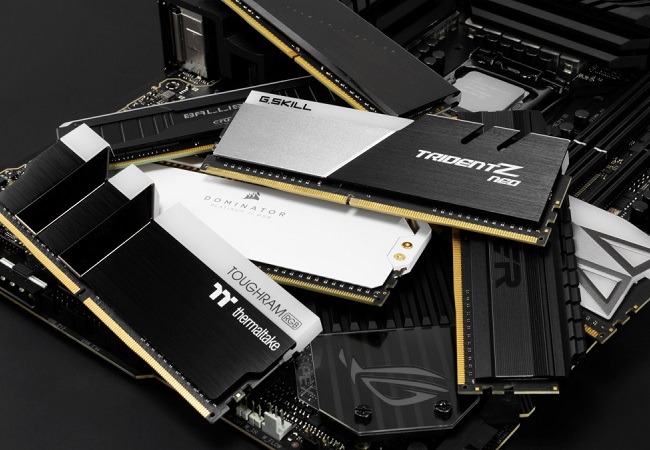Crucial Ballistix RGB DDR4 1x16Gb BL16G36C16U4RL
 | Outdated Product A spectacular module of high-speed overclocking DDR4 RAM, which is capable of stable operation at a frequency of 3600 MHz. In addition to the impressive volume (16 GB) and impressive bandwidth (28.8 Gbps), an important feature of the module was the use of RGB LED backlight, the glow of which can be controlled using proprietary software or popular technologies from motherboard manufacturers (Asus Aura Sync, Gigabyte RGB Fusion, MSI Mystic Light and ASRock Polychrome Sync). It is positioned as a high-end 2021 product aimed at demanding gamers, overclocking enthusiasts and modding enthusiasts. Designed for installation in gaming and demonstration-exhibition systems. The Crucial Ballistix RGB DDR4 1x16Gb RAM module is capable of stable operation at 3600 MHz in dual-channel mode with CL16-18-18...-36 timings at 1.35 V. This mode is easily activated using XMP 2.0 technology. If the motherboard does not support it, then the necessary parameters can be configured manually in the corresponding section of the UEFI BIOS. Compatible with Intel Core (6th generation and above) and AMD Ryzen processor-based configurations. |
Crucial BL16G36C16U4RL | |||||||||||||||||||||||||||||||||||||
| |||||||||||||||||||||||||||||||||||||
A spectacular module of high-speed overclocking DDR4 RAM, which is capable of stable operation at a frequency of 3600 MHz. In addition to the impressive volume (16 GB) and impressive bandwidth (28.8 Gbps), an important feature of the module was the use of RGB LED backlight, the glow of which can be controlled using proprietary software or popular technologies from motherboard manufacturers (Asus Aura Sync, Gigabyte RGB Fusion, MSI Mystic Light and ASRock Polychrome Sync).
It is positioned as a high-end 2021 product aimed at demanding gamers, overclocking enthusiasts and modding enthusiasts. Designed for installation in gaming and demonstration-exhibition systems. The Crucial Ballistix RGB DDR4 1x16Gb RAM module is capable of stable operation at 3600 MHz in dual-channel mode with CL16-18-18-36 timings at 1.35 V. This mode is easily activated using XMP 2.0 technology. If the motherboard does not support it, then the necessary parameters can be configured manually in the corresponding section of the UEFI BIOS. Compatible with Intel Core (6th generation and above) and AMD Ryzen processor-based configurations.
Always clarify the specifications and configuration of the product with the online store manager before purchasing.
Catalog Crucial 2025 - new arrivals, bestsellers, and the most relevant models Crucial.


Closed production cycle
A couple of years ago, the American manufacturer Crucial broke into the memory market with their low-cost and not-so-low-cost SSDs and RAM. In fact, “burst” is not a very correct term, rather it was a return to basics, since one of the largest manufacturers of Micron memory microchips stands behind Crucial. Therefore, one of the main selling points of the Ballistix series has become a complete production cycle with high quality control.
16 GB kit @ 3600 MHz
Our test kit includes a single 16 GB Ballistix stick with a red aluminium heatsink that serves as additional cooling for the chips and the memory controller. A translucent light guide is fixed at the end, through which RGB elements are translucent. Thanks to the use of e-die chips, the memory proved to be worthy in operation and wound up at the claimed 3600 MHz, immediately picking up its factory XMP profile. Given Ballistix's past successful overclocking experience and low stock latencies, we hoped that our version would be able to hit the 4200 MHz mark. However, the system was acting up, so it was decided to go down to 4000 MHz. On the test system with Intel, the problem was solved instantly, on the motherboard with AMD, I had to tinker a little with the values of the CAS profile and voltage.
Price, quality and reliability
Perhaps the main charm of the test sample is the price. A single bar with a capacity of 16 GB will cost 10 – 15% cheaper than most popular overclocker kits with an identical capacity and the same frequency of 3600 MHz. It turns out to be especially profitable if you assemble a system with a serious amount of RAM and buy 2, 3 or 4 bars at once to work in multi-channel mode. But in the role of a single memory module, this is no longer such an interesting option, since the dual-channel mode gives a small but sure increase in performance in modern games and resource-intensive applications.






